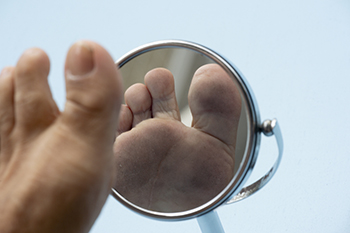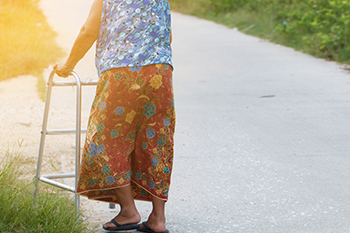Connect With Us
Blog
Items filtered by date: March 2022
Preventing Foot Problems in Children
 Parents can help their children prevent foot problems and associated pain as they age by taking care of and teaching their children to take proper care of their feet. Developing healthy foot habits in children starts with parents washing their children’s feet each day and making sure they are dry, buying shoes that fit properly (with enough room in the toe box to allow for growth), using right sized cotton and/or wool socks on children’s feet to keep them warm and allow room for development, cutting toenails straight across and not too short to prevent ingrown toenails, and allowing children to go barefoot in the home so their feet will grow and gain strength without restriction. Taking children to a podiatrist early on can start them off right, provide a baseline for their foot development, and introduce them to a specialist who will be able to diagnose and treat any foot problems that might arise in their lives.
Parents can help their children prevent foot problems and associated pain as they age by taking care of and teaching their children to take proper care of their feet. Developing healthy foot habits in children starts with parents washing their children’s feet each day and making sure they are dry, buying shoes that fit properly (with enough room in the toe box to allow for growth), using right sized cotton and/or wool socks on children’s feet to keep them warm and allow room for development, cutting toenails straight across and not too short to prevent ingrown toenails, and allowing children to go barefoot in the home so their feet will grow and gain strength without restriction. Taking children to a podiatrist early on can start them off right, provide a baseline for their foot development, and introduce them to a specialist who will be able to diagnose and treat any foot problems that might arise in their lives.
Making sure that your children maintain good foot health is very important as they grow. If you have any questions, contact one of our podiatrists of Nassau Foot & Ankle. Our doctors can provide the care you need to keep you pain-free and on your feet.
Keeping Children's Feet Healthy
Having healthy feet during childhood can help prevent medical problems later in life, namely in the back and legs. As children grow, their feet require different types of care. Here are some things to consider...
Although babies do not walk yet, it is still very important to take care of their feet.
Avoid putting tight shoes or socks on his or her feet.
Allow the baby to stretch and kick his or her feet to feel comfortable.
As a toddler, kids are now on the move and begin to develop differently. At this age, toddlers are getting a feel for walking, so don’t be alarmed if your toddler is unsteady or ‘walks funny’.
As your child gets older, it is important to teach them how to take care of their feet.
Show them proper hygiene to prevent infections such as fungus.
Be watchful for any pain or injury.
Have all injuries checked by a doctor as soon as possible.
Comfortable, protective shoes should always be worn, especially at play.
If you have any questions please feel free to contact our offices located in Oceanside, Franklin Square, and East Norwich, NY . We offer the newest diagnostic and treatment technologies for all your foot and ankle needs.
Checking Your Feet if You Have Diabetes
 We often take our feet for granted, paying little or no attention to them, until they begin to hurt. But if you have diabetes, you may not be able to feel pain in your extremities, and that’s where the trouble really starts. Professionals believe that it’s important for diabetics to develop a daily foot-care action plan to help prevent minor problems from becoming major ones. It is a good idea to use a magnifying glass to inspect the feet and toes, along with a mirror to see the bottom of your feet. If that is impossible, you may need to ask a healthcare worker to help with the exam. A foot-care checklist can include checking the feet and toes for: redness or bruising; breaks in the skin; blisters or calluses; peeling skin; moisture between the toes; feelings of numbness, pins and needles or burning; ingrown toenails; and sores or ulcers. Many of these symptoms may indicate other maladies that, if ignored, can develop into more serious problems. It is also suggested that anyone with diabetes makes regular appointments with a podiatrist who can examine your feet and toes and treat them early, if needed.
We often take our feet for granted, paying little or no attention to them, until they begin to hurt. But if you have diabetes, you may not be able to feel pain in your extremities, and that’s where the trouble really starts. Professionals believe that it’s important for diabetics to develop a daily foot-care action plan to help prevent minor problems from becoming major ones. It is a good idea to use a magnifying glass to inspect the feet and toes, along with a mirror to see the bottom of your feet. If that is impossible, you may need to ask a healthcare worker to help with the exam. A foot-care checklist can include checking the feet and toes for: redness or bruising; breaks in the skin; blisters or calluses; peeling skin; moisture between the toes; feelings of numbness, pins and needles or burning; ingrown toenails; and sores or ulcers. Many of these symptoms may indicate other maladies that, if ignored, can develop into more serious problems. It is also suggested that anyone with diabetes makes regular appointments with a podiatrist who can examine your feet and toes and treat them early, if needed.
Diabetic foot care is important in preventing foot ailments such as ulcers. If you are suffering from diabetes or have any other concerns about your feet, contact one of our podiatrists from Nassau Foot & Ankle. Our doctors can provide the care you need to keep you pain-free and on your feet.
Diabetic Foot Care
Diabetes affects millions of people every year. The condition can damage blood vessels in many parts of the body, especially the feet. Because of this, taking care of your feet is essential if you have diabetes, and having a podiatrist help monitor your foot health is highly recommended.
The Importance of Caring for Your Feet
- Routinely inspect your feet for bruises or sores.
- Wear socks that fit your feet comfortably.
- Wear comfortable shoes that provide adequate support.
Patients with diabetes should have their doctor monitor their blood levels, as blood sugar levels play such a huge role in diabetic care. Monitoring these levels on a regular basis is highly advised.
It is always best to inform your healthcare professional of any concerns you may have regarding your feet, especially for diabetic patients. Early treatment and routine foot examinations are keys to maintaining proper health, especially because severe complications can arise if proper treatment is not applied.
If you have any questions please feel free to contact our offices located in Oceanside, Franklin Square, and East Norwich, NY . We offer the newest diagnostic and treatment technologies for all your foot and ankle needs.
Gout Pain Can Be Managed
Why Falls Are a Problem for Older Adults
As we age, several factors combine to make the threat of a fall more prevalent. Balance problems, weaker muscles and poorer eyesight may all contribute to the likelihood of a fall. Most falls happen in the home, and can be caused by inadequate lighting, unsafe footwear, slippery floors, loose rugs and electrical cords, and uneven surfaces. Certain physical conditions, such as low blood pressure, incontinence, and diabetes also may increase the chances of a fall. Many of these issues can be controlled with a few simple lifestyle changes. However, if an elderly person falls more and more often, certain complications may ensue. Among them are hip and thigh fractures, head injuries, wrist fractures, and even a tendency to become more sedentary, which further weakens the muscles. If falling has become a problem for you, it’s a good idea to make an appointment with a podiatrist who can help you find ways to prevent injury and reduce any greater risk to your health.
Preventing falls among the elderly is very important. If you are older and have fallen or fear that you are prone to falling, consult with one of our podiatrists from Nassau Foot & Ankle. Our doctors will assess your condition and provide you with quality advice and care.
Every 11 seconds, an elderly American is being treated in an emergency room for a fall related injury. Falls are the leading cause of head and hip injuries for those 65 and older. Due to decreases in strength, balance, senses, and lack of awareness, elderly persons are very susceptible to falling. Thankfully, there are a number of things older persons can do to prevent falls.
How to Prevent Falls
Some effective methods that older persons can do to prevent falls include:
- Enrolling in strength and balance exercise program to increase balance and strength
- Periodically having your sight and hearing checked
- Discuss any medications you have with a doctor to see if it increases the risk of falling
- Clearing the house of falling hazards and installing devices like grab bars and railings
- Utilizing a walker or cane
- Wearing shoes that provide good support and cushioning
- Talking to family members about falling and increasing awareness
Falling can be a traumatic and embarrassing experience for elderly persons; this can make them less willing to leave the house, and less willing to talk to someone about their fears of falling. Doing such things, however, will increase the likelihood of tripping or losing one’s balance. Knowing the causes of falling and how to prevent them is the best way to mitigate the risk of serious injury.
If you have any questions, please feel free to contact our offices located in Oceanside, Franklin Square, and East Norwich, NY . We offer the newest diagnostic and treatment technologies for all your foot care needs.
Types of Athlete's Foot
 The most common type of athlete’s foot is referred to as chronic interdigital. Symptoms that are associated with this condition often include itchiness between the toes and on the bottom of the foot. It can develop as a result of wearing shoes that are too small, and this can create a warm environment that is perfect for fungus to grow in. The least common type of athlete’s foot is known as vesicular, and this can produce blisters that are painful on the bottom or top of the foot. Athlete’s foot is contagious and may be prevented by wearing appropriate shoes in public showers. If you have developed this uncomfortable foot condition, it is strongly suggested that you consult with a podiatrist who can begin the correct treatment for you.
The most common type of athlete’s foot is referred to as chronic interdigital. Symptoms that are associated with this condition often include itchiness between the toes and on the bottom of the foot. It can develop as a result of wearing shoes that are too small, and this can create a warm environment that is perfect for fungus to grow in. The least common type of athlete’s foot is known as vesicular, and this can produce blisters that are painful on the bottom or top of the foot. Athlete’s foot is contagious and may be prevented by wearing appropriate shoes in public showers. If you have developed this uncomfortable foot condition, it is strongly suggested that you consult with a podiatrist who can begin the correct treatment for you.
Athlete’s foot is an inconvenient condition that can be easily reduced with the proper treatment. If you have any concerns about your feet and ankles, contact one of our podiatrists from Nassau Foot & Ankle. Our doctors will treat your foot and ankle needs.
Athlete’s Foot: The Sole Story
Athlete's foot, also known as tinea pedis, can be an extremely contagious foot infection. It is commonly contracted in public changing areas and bathrooms, dormitory style living quarters, around locker rooms and public swimming pools, or anywhere your feet often come into contact with other people.
Solutions to Combat Athlete’s Foot
- Hydrate your feet by using lotion
- Exfoliate
- Buff off nails
- Use of anti-fungal products
- Examine your feet and visit your doctor if any suspicious blisters or cuts develop
Athlete’s foot can cause many irritating symptoms such as dry and flaking skin, itching, and redness. Some more severe symptoms can include bleeding and cracked skin, intense itching and burning, and even pain when walking. In the worst cases, Athlete’s foot can cause blistering as well. Speak to your podiatrist for a better understanding of the different causes of Athlete’s foot, as well as help in determining which treatment options are best for you.
If you have any questions please feel free to contact our offices located in Oceanside, Franklin Square, and East Norwich, NY . We offer the newest diagnostic and treatment technologies for all your foot and ankle needs.
Why Stretch the Plantar Fascia?
The plantar fascia is a ligament that runs along the bottom of your foot, connecting the heel bone to the toes. This strong ligament supports the arch of the foot, providing it with strength, stability, and shock absorption as you go about your day. Stretching the plantar fascia can help keep it strong, flexible, and healthy, preventing debilitating injuries and foot pain. Stretching is also helpful if you are recovering from a plantar fascia injury. One simple stretch that you can do is a towel scrunch. Sit in a chair and place a towel flat on the floor in front of you. Using just your toes, scrunch up the towel, pulling it towards you. For more information about the benefits of stretching the plantar fascia, please consult with a podiatrist.
Stretching the feet is a great way to prevent injuries. If you have any concerns with your feet consult with one of our podiatrists from Nassau Foot & Ankle. Our doctors will assess your condition and provide you with quality foot and ankle treatment.
Stretching the Feet
Stretching the muscles in the foot is an important part in any physical activity. Feet that are tight can lead to less flexibility and make you more prone to injury. One of the most common forms of foot pain, plantar fasciitis, can be stretched out to help ease the pain. Stretching can not only ease pain from plantar fasciitis but also prevent it as well. However, it is important to see a podiatrist first if stretching is right for you. Podiatrists can also recommend other ways to stretch your feet. Once you know whether stretching is right for you, here are some excellent stretches you can do.
- Using a foam roller or any cylindrical object (a water bottle or soda can will do), roll the object under your foot back and forth. You should also exert pressure on the object. Be sure to do this to both feet for a minute. Do this exercise three times each.
- Similar to the previous one, take a ball, such as a tennis ball, and roll it under your foot while seated and exert pressure on it.
- Grab a resistance band or towel and take a seat. If you are using a towel, fold it length wise. Next put either one between the ball of your foot and heel and pull with both hands on each side towards you. Hold this for 15 seconds and then switch feet. Do this three times for each foot.
- Finally hold your big toe while crossing one leg over the other. Pull the toe towards you and hold for 15 seconds. Once again do this three times per foot.
It is best to go easy when first stretching your foot and work your way up. If your foot starts hurting, stop exercising and ice and rest the foot. It is advised to then see a podiatrist for help.
If you have any questions, please feel free to contact our offices located in Oceanside, Franklin Square, and East Norwich, NY . We offer the newest diagnostic and treatment technologies for all your foot care needs.
Blog Archives
- April 2025
- March 2025
- February 2025
- January 2025
- December 2024
- November 2024
- October 2024
- September 2024
- August 2024
- July 2024
- June 2024
- May 2024
- April 2024
- March 2024
- February 2024
- January 2024
- December 2023
- November 2023
- October 2023
- September 2023
- August 2023
- July 2023
- June 2023
- May 2023
- April 2023
- March 2023
- February 2023
- January 2023
- December 2022
- November 2022
- October 2022
- September 2022
- August 2022
- July 2022
- June 2022
- May 2022
- April 2022
- March 2022
- February 2022
- January 2022
- December 2021
- November 2021
- October 2021
- September 2021
- August 2021
- July 2021



